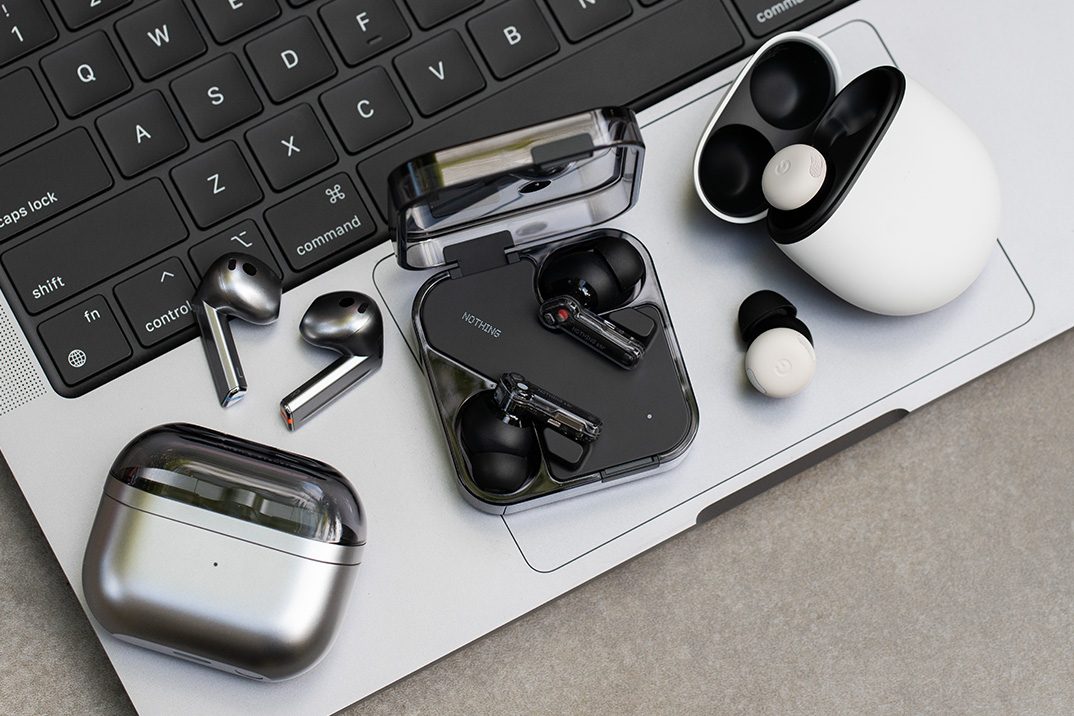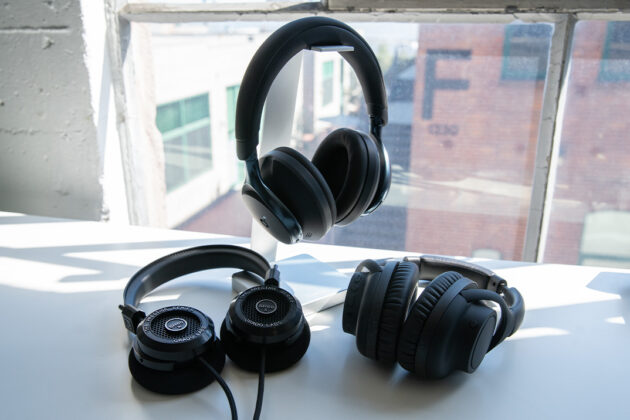8 Awesome New Menswear Arrivals From Devereux To Start 2026 In Style
Dec 20, 2025Tested: 5 Best AirPod Alternative Wireless Earbuds
- Nov 19, 2024
- 0 Comments
233

Apple’s AirPods are handsome, capable, easy to use, and loaded with user-friendly features ranging from stellar audio quality to an onboard microphone that’s compatible with both Siri and calls, and a good deal more. But they’re also far from the only option on the market. In fact, there are a number of wireless earbuds you can get right now that are suitable alternatives to the AirPods, and some of them have features that make them just as capable as Apple’s flagship headphones. While the AirPods certainly have a stranglehold in regards to popularity, they’re still not for everyone. If you want to stay off the Apple train but still want a solid pair of true wireless earbuds, check out our guide where we tested the best AirPods alternatives.
The Best AirPods Alternatives Breakdown
how We Tested
There are tons of wireless earbuds on the market, and a lot of them are trying to be Apple’s AirPods, who essentially paved the way in the category. Nevertheless, it’s been long enough that you’ll find quite a lot of discrepancy within the space, especially as brands try to implement their own revered tech and/or do so at a competitive price. For this guide, we looked at our favorite brands and models that we, ourselves, would opt for if AirPods weren’t available. We looked at brand reputation, price, ANC tech, aesthetic, and any other features.
For testing, we used each and every earbud model for a significant amount of time, listening to an array of songs across all genres, as well as podcasts. If there was an accompanying app, we looked at how the apps affected the audio quality. Other things we looked at were ANC effectiveness, comfort, loudness, and how versatile the audio was. Our results are detailed below.
What to Look For
Playtime: According to Apple, the AirPods Pro 2nd generation holds a charge for six hours of playback, which can be extended by thirty hours via the included charging case. Of course, even with a fully charged case, you’ll still have to stop listening after six hours to charge them back up again. So, when looking at alternatives, anything with ~six hours of listening time is a solid choice, but keep in mind that using features like ANC and making calls will drain the battery faster (usually by an hour or two).
Case Battery: The AirPod Pros provide thirty hours of listening time on a full charge with the case, and most alternatives are in the same ballpark. Do note that many companies include the initial listening time in the total battery life provided by a charging case.
Water Resistance: The current AirPods Pros are IPX4 sweat and water-resistant, and many competitors have followed suit. Some even have IP54 ratings that kick it up a notch with dust resistance. If you plan on working out, then getting a pair with water/sweat resistance is a must.
Sound Quality: Sound quality is one of the most important factors to consider when selecting a pair of headphones. Luckily, every pick in our guide has clear audio with balanced mids and highs, but keep in mind that sound quality generally improves as price increases. That’s not to say budget picks will sound bad, but you’ll hear more details with high-end picks.
Noise Cancellation: The main difference here is between active noise cancellation (ANC) and passive noise cancellation. Headphones with active noise cancellation have built-in technology and mics that listen to ambient noise, and then generate frequencies to cancel it out. Passive noise cancellation, on the other hand, does not use any technology, but rather the shape and design of the headphones to naturally isolate sound. At this point in the industry, any noise-canceling headphones worth their salt will have ANC, but if it’s not a big deal to you personally, you can save some money going without it.
Features: Now that AirPods, and wireless earbuds on the whole, are ubiquitous, there are a handful of features we’ve come to expect from them. Touch controls, voice commands, and even sweatproof design are all important features to consider, as they make your headphones more intuitive and handy.
Compatibility: Every pick in our guide is compatible with both iOS and Android devices, but some headphones may have features that work better with certain operating systems.
Soundcore Liberty 4
Pros
- Best EQ options we’ve seen in an app.
- Great with podcasts and calls
- Comfortable for squish-tip buds
- Each bud glows individually when charged in case
Cons
- Touch functions are too sensitive; we kept accidentally turning the earbuds off
- Default audio isn’t the best without EQuing
Best Budget Pick: Anker has made a name for itself in developing spectacular portable chargers for unbelievably fair prices. And it does so again with its entry-level audio brand Soundcore. The Liberty 4 isn’t the cheapest option from the company but it’s still the cheapest on this list –– and that’s quite impressive considering how great they are. Boasting IPX4 water resistance, the earbuds will get you 10 hours of playback and 50 with the case, and its adaptive noise cancellation gets paired with 11mm drivers and LDAC tech for high-end sound that might just be better than some of the upper-tier headphones. Lastly, it utilizes six microphones and AI-boosted algorithms for superior call performance.
The Sound
It goes without saying that such a budget pick won’t necessarily have the best audio quality, but the Soundcore Liberty 4 is nothing to sneeze at. First of all, I love the volume range here, which really helps a lot with calls and podcasts. I also found myself reaching for these more when listening to podcasts, since the voices sounded the most lifelike of the options I tested, rather than too bassy or trebly.
As far as music, I found the default audio to have some struggles with balance and consistency. For instance, with hip-hop music, the bass felt like it was getting “eaten” a bit, meaning it wasn’t enunciated as much, serving more as an underlying drone, albeit still present. On the other hand, with rock music, I found the lows to be spot on, while the singing vocals could have served to stand out more.
On the other hand, the Soundcore app integration is key to maximizing your enjoyment of the earbuds. This is where you can activate its noise cancellation and even customize its levels and wind noise reduction. The app also has a very intricate EQ control, among the best I’ve seen for an audio brand. As I said, the default audio for music struggled with balance, but when you turn on the 3D Surround Sound, you’ll notice a fantastic blend. If these features aren’t enough, there’s a very cool HearID Sound option that creates a personalized audio profile, which puts you through a thorough hearing test and a series of sound preference tests to figure out how you like your music EQed. At the end of it all, I’m not sure I preferred the HearID Sound over the Default settings with 3D Surround Sound, but nevertheless, I was highly impressed with how thoughtful these features were.
The Look and Comfort
Because of my ear shape, I’m not the biggest fan of the squish-tip earbuds but I was surprised at how comfortable the ones on the Soundcore were, which was in part thanks to the innate shape of the buds themselves. Also, there are four tip sizes you can choose from just in case. However, when it did come time to adjust the buds, I kept accidentally pausing my music since the touch feature is right on the top and pretty sensitive.
In terms of visual aesthetic, the Soundcore Liberty 4 is surprisingly attractive, with a more rounded take on the typical AirPod. I tested the navy blue variant, which I was a particular fan of; they added a splash of color without being too bold. It’s also important to note that the “L” and “R” indications isn’t easy to see, especially in low light.
The Case
I really liked the case here. Not only does it feel very robust and durable, with an attractive matte metallic coat, but it has some nice functions like an easy button opening and an individual glow for each bud to acknowledge that it’s being charged. It’s cool too, because you can open the case without the button as well, in case it ever gets jammed or anything.
As much as I liked the case, I did wish there were a way to check on its charging status without opening it up. For instance, the Samsung case has a bottom button that you can press to check its power.
Verdict: Don’t let the low price tag fool you, the Soundcore Liberty 4 will challenge the best earbuds on this list, simply for its intuitive app and one of the best EQ functions we’ve ever seen in any personal audio device. Favorable for calls and podcasts, the headphones won’t give you the best default audio for music but that can be adjusted. We also loved the thoughtfully-designed case, equipped with single-hand opening and individual glowing to let you know if it’s being charged.
Playtime: 10 hours
Case Battery: 50 hours
Noise Cancellation: ANC
Water Resistance: IP57
Nothing Ear
Pros
- Very cool design
- Intricate EQ controls improve music a lot
- When EQed properly, this gives some of the best audio quality.
- Intuitive case design
Cons
- Touch functions often frustrating to use
- Kept requiring adjustment in-ear
- Poor default sound with both music and voice
Editor’s Pick: Nothing has been making waves in the tech industry these last few years with minimalist, transparent devices, and an equally sleek OS. The label’s lightweight Ear headphones are its flagship audio offering, and despite the lightweight and minimal look, they’re packed with a lot to be impressed by. Like the 40.5 hours of total playtime (~8.5 hours of non-ANC playback without the case) you’re getting with Hi-Res audio, and the active noise cancellation to make it even better. Featuring a new ceramic diaphragm that increases movement by 110% compared to the outgoing model, the earbuds are IP54 dust and water-resistant, and the case is IP55 dust and water-resistant, making these quite rugged, too. They also come ready to go with a companion app that gives you some more features, like convenient EQ customization options.
The Sound
My biggest issue with the Nothing Ear came with its sound. Now, it wasn’t all bad news. I actually loved how the default EQing sounded with rock genres. However, in terms of hip-hop and bass-heavy tunes, the buds seemed ill-equipped to handle the complexities. Likewise, without any mixing, podcast voices sounded a bit distant some of the time, with either too much bass or lower highs.
As for the app-based EQing controls, the Nothing Ear is quite intricate. I had a lot of fun playing around with the range of sound profiles. There’s also both a “simple” and “advanced” set of EQ panels. However, I opted for the more balanced controls across all genres. This did help with the bass-heavy music, to the point that, with EQing, the Nothing earbuds were actually some of the best-sounding of the bunch. Also, there’s a hearing test that’s a bit more conclusive than the Soundcore, albeit not as accurate based on how the mechanics of the test went.
I also didn’t love the array of touch-based operations, finding them pretty finicky and never doing what I needed them to do. The pinching method is supposed to prevent you from incidentally altering what the buds are doing, but that happened regardless. The force sensors are at the base of each bud, which makes it easier to adjust without accidentally touching it, but also, because there are so many specific pattern and pressure requirements, I found myself just taking these out of my ear each time I needed to do operate them anyway.
The Look and Comfort
For squish-tip earbuds, these aren’t terribly uncomfortable for me. However, I found myself adjusting them quite often, especially when trying to get the sound of the music right. However, for calls and podcasts, the fit was just fine. Also, like some others, these come with three different tip-size options.
On the other hand, in terms of the look of the Nothing Ear, these are easily my favorite of the bunch. Nothing is a brand that’s built itself around blending both form and function, and this definitely comes through here, even leaning towards the former. I love the minimalist appearance but also the transparent shell that’s a real conversation starter.
The Case
Compared to the rounder-shaped cases of other buds, the one for the Nothing Ear has somewhat of a weird design. It’s a flat, square-shaped case with a transparent lid, and it has a concave divot in one corner. This was super useful when searching for the case inside my crowded pocket. While it doesn’t open somewhat easily, I loved being able to get out the buds with one hand. Meanwhile, the flat design prevented it from being too bulky in my pocket.
Verdict: Obviously design-forward compared to its competitors, the Nothing Ear has some unique features that set it apart such as its in-depth EQ functions and personalized hearing tests. We loved how intuitive the case design was and how well it fit into our pockets. However, the touch-based controls were a bit too finicky to our liking. Nevertheless, when EQed properly, this yielded one of the best-sounding buds of the bunch.
Playtime: 5 to 8.5 hours
Case Battery: 40.5 hours
Noise Cancellation: ANC
Water Resistance: IP54
Samsung Galaxy Buds3
Pros
- Superior battery life
- High water resistance
- Great music playback quality across the board
- Cool minimalist case designll
- Comfortable in-ear
Cons
- Not easy to hold in hand; slippery
- Doesn’t get loud; not as good for podcasts or calls
- No app presence
- Trouble pairing with iPhone
Best for Samsung Users: While they’re not quite approaching Apple in the tech race, Samsung is still one of the Cupertino-based brand’s chief competitors. And it’s easy to see why in the quality and suite of features stuffed into the Galaxy Buds 3. Boasting built-in sound tech from AKG — a superb sound engineering company that dates back to 1947 — these truly wireless earbuds boast a host of specs that are easily comparable to the AirPods. They offer a water-resistance rating of IP57, AI-assisted adaptive EQing, and even real-time language translation capability. For those making calls often, these also come with HD voice technology. These also offer superior battery compared to its competitors, with 24 hours of ANC playback and a whopping 515 hours inside the case!
The Sound
You wouldn’t guess it but the Samsung Galaxy Buds3 have about the best default audio capabilities of any earbuds I tested. This might be due to the lack of EQing ability since there’s no true accompanying app, but I was impressed with the results. For rock, the audio was fairly analogous to what it would sound like out of a bookshelf speaker. As for hip-hop, it was just a small step down, handling the blend of vocals and bass very well. It didn’t struggle to achieve a richness in sound.
For some reason, the Galaxy Buds3 doesn’t get very loud, which was a problem for calls and podcasts, although the quality was still favorable.
The Look and Comfort
In-hand, I struggled a bit to hang onto these. I don’t love the lack of grip on the Galaxy Buds3, being that I’m not the most nimble of individuals and found that these kept slipping out of my hands; I literally dropped these almost every time I used them. Being some of the only non-squish-tip earbuds, I tended to be partial to wearing these since they were more comfortable in my ear. When driving, for instance, I didn’t have to keep taking my hands off the wheel to adjust them.
Looks-wise, these aren’t ugly but they do look rather generic, but if you want something more similar to the AirPods, they might be a good choice.
The Case
Despite the cheap-feeling plastic at the top of the case, the case itself is one of the more attractive that we tested, with a sleek design, absence of branding, and a clear top that easily lets you see if your buds are inside or not. Its green and red light signifiers are pretty convoluted, and there’s not a lot of info provided by the brand.
Speaking of which, there’s no real app presence for these. Luckily, the audio sounds great without any EQing but it’s just odd that even with a Samsung phone, I couldn’t download an app that works for these. There is a Samsung Galaxy Buds app but it only recognizes the Buds Live and Buds+ models. Also, these didn’t pair with iPhone, so keep that in mind!
Verdict: There might not be a good app to use with the Samsung Galaxy Buds3 but the default audio without EQing is pretty great, and eclectic across the board. On the surface, these earbuds have tremendous battery life and superior durability with the highest water resistance on this list. We didn’t love how they felt in-hand, slipping from our grips often, but when they’re in your ear, they’re pretty comfortable.
Playtime: 24 hours
Case Battery: 515 hours
Noise Cancellation: ANC
Water Resistance: IP57
Google Pixel Buds Pro 2
Pros
- Better ANC than your average buds
- Cool, minimalist design
- Very responsive touch functions
- Sleek, minimalist case
- Doesn’t get in the way with hanging sticklllllll
Cons
- Case is also quite heavy despite just moderate charge time
- Pricier
Best Overall Pick: Leave it to Google to make one of the best wireless earbuds around. With an assertive design language that looks great while also offering meaningful utility, the Pixel Buds Pro 2 are designed for comfort, have Gemini AI assistance, and twice the active noise cancellation of the competition thanks to the Tensor A1 chip, which runs 90x the speed of sound. There’s also the ability to allow audio transparency at the touch of your finger. Battery-wise, you’ll get anywhere from 5 to 8 hours, depending on ANC usage, and between 24 and 30 hours with the case.
The Sound
These earbuds have almost identical tap functions as that on the Nothing Ear above, but they are placed on the giant round capsule on top and are far more responsive. You can play, pause, skip, and toggle ANC on and off. I never had an issue when transitioning from transparent audio to ANC. And by the way, the ANC is certainly more effective here. It just so happened that people were chopping down a tree in my neighborhood one day last week, so I was able to put these in and work without distraction, which was pretty awesome. I was testing a couple of other buds from this guide that day and didn’t have as much success.
When it came to the audio itself, the Google Pixel Buds Pro 2 was my favorite. With rock genres, the quality was superb, rivaled only by the Galaxy Buds3 above, likewise for rap and bass-heavy genres, with excellent balance. Also like the Galaxy earbuds, there’s no app here for EQing, perhaps making the default audio more accountable out of the box. I really loved using these. However, it’s also important to note that these earbuds don’t get very loud by default, making them less than ideal for podcasts and calls.
The Look and Comfort
The Google Pixel Buds kinda have a strange look that made me pause before putting them in my ear. It took me a second to figure out how to insert them, but I quickly realized that if I keep the “G” logo level, they’ll go right in. I was a big fan of the low-profile and minimalist exterior design. These don’t have those pesky sticks that hang down and, thus, are more discreet. On other buds, the sticks can often create some equivocation as to where to press when pausing or skipping tracks. Here, it was obvious that you needed to touch the giant circle on the outside.
The Case
Unlike other buds that require you to keep them in the case for pairing, these Pixel Buds can pair out of the case, which is helpful. The case itself sports a sleek, minimalist design and was my favorite of the bunch. Despite these being from one of the biggest companies in the world, there’s absolutely zero branding on the outside, which is interesting too.
It’s also important to note the case’s flaws as well, such as its heavier weight despite not having a particularly impressive charging time (just 30 hours max). Also, while the buds themselves are IP54 rated for water resistance, the case is just IPX4, meaning it’s not dust-resistant.
Verdict: Despite having the price of most premium earbuds, the Google Pixel Buds Pro 2 are arguably the best here. While they don’t have an accompanying app, they also don’t really need it. Performing well across genres, the headphones have easy touch-based features, a cool minimalist design that doesn’t get in the way, and the best noise-cancellation on this guide. These are hard to beat.
Playtime: 5 to 8 hours
Case Battery: 24 to 30 hours
Noise Cancellation: ANC
Water Resistance: IP54
Bose QuietComfort Ultra Earbuds
Pros
- Sound most comparable to headphones
- Eclectic audio quality
- Very comfortable, especially when working out.
- Great touch response
- You can turn off ANC and transparency altogether
Cons
- Not super attractive
- Not the best battery life
Best Premium Pick: While they’re not quite as durable in regards to moisture-resistance as some others here, Bose’s QuietComfort Ultra Earbuds are no slouch, and feature some of the best noise cancellation on the market. Pair that with a trio of interchangeable tips and stability bands to make the fit both comfortable and secure, and these are definitely a suitable alternative. They also feature about the same battery life as AirPods, have dual integrated microphones for easy calling, offer top-tier audio-video synchronization when paired with an iPhone or iPad, and more. And the cherry on top of the cake is that you can use it alongside the Bose Music app to adjust the settings and EQ to your liking.
The Sound
When it comes to crystalline audio in a compact package, Bose is one of the best. And with this price tag, you do expect the creme de la creme. After most of my testing was concluded, I found myself reaching for these the most for simply listening to music. While the Bose app does allow you do adjust the EQ, these are superb right out the box, which I can only really say for the models that didn’t have true apps (i.e., the Galaxy and Google models).
Essentially across all genres, the Bose QuietComfort Ultra is really perfect. Wireless earbuds aren’t going to be as good as wired headphones. However, these felt quite similar to how my mixing headphones sound, which is impressive all things considered, and not what I expected to find anywhere on this list.
The touch response here is also really great. While the ANC is comparable to the Google buds above, which was my favorite, I also loved how you can long-press the buds to turn on transparency mode or –– and this is unique –– choose to turn both off altogether. Sometimes I don’t really want ANC when listening to music, nor do I want transparency mode. So, these worked for me.
The Look and Comfort
While these aren’t specifically made for working out, the way they fit inside my ear made them my choice for the gym. They felt locked into place and I didn’t really need to adjust them hardly at all.
In terms of the look, I wasn’t the biggest fan of the QuietComfort Ultra. In fact, I’m more partial to the non-Ultra model a tier below in terms of aesthetic. Nevertheless, visual appeal is only a small part to the overall picture here. It’s just admittedly surprising that a brand like Bose couldn’t have made something a bit less utilitarian-looking.
The Case
Even if you are partial to the cheaper non-Ultra QuietComfort buds, the case on the Ultra is much less bulky. You’ll get a thinner, shorter case that just fits in your pocket seamlessly. It’s also equipped with a keyring hole, which is a unique feature among the units we’ve tested. You can plausibly put these on your backpack or keys without feeling like you’ll lose them, which is nice.
However, the battery life on the QuietComfort Ultra isn’t ideal but you can get a solid 24 hours with the case charging (though, you’ll likely have to recharge each night). It’s also important to note that these are not as durable as others, with only a splash-resistant IP rating and no dust resistance.
Verdict: Not winning any awards for its battery life, the Bose QuietComfort Ultra is easily the finest pair of earbuds on this list in terms of audio quality alone. The Bose app gives you extra EQ controls but you honestly won’t really need them. We loved how locked in these felt in-ear and how well you can toggle on and off the ANC and transparency –– and opt out of both altogether.
Playtime: 6 hours
Case Battery: 24 hours
Noise Cancellation: ANC
Water Resistance: IPX4
AirPod Alternatives Comparison Chart
| Earbuds | Playtime | Case Battery | Noise Cancellation | Water Resistance |
|---|---|---|---|---|
| Soundcore Liberty 4 | 10 hours | 50 hours | ANC | IP57 |
| Nothing Ear | 5 to 8.5 hours | 40.5 hours | ANC | IP54 |
| Samsung Galaxy Buds3 | 24 hours | 515 hours | ANC | IP57 |
| Google Pixel Buds Pro 2 | 5 to 8 hours | 24 to 30 hours | ANC | IP54 |
| Bose QuietComfort Ultra Earbuds | 6 hours | 24 hours | ANC | IPX4 |
Honorable Mentions
The Bang & Olufsen Beoplay EX is just a super high-end pair that features much better audio quality than the AirPods, plus comes loaded with adaptive ANC, transparency mode, an adaptive and customizable EQ, an IP57 rating, the same battery life as the AirPods, auto-pause and play, and multi-point connectivity — i.e. the vast majority of the features and tech found on the AirPods. The design is also nice and the glass touch controls are really cool as well. We simply weren’t able to get hands-on with this model, but they shouldn’t be ignored.
Beats are a popular option, especially for gym rats. These Studio Buds+ work with Apple’s Find My, have solid battery life, and are actually from a brand owned by Apple itself.
Bowers & Wilkins’ Pi6 is another premium pair to consider if shopping for AirPods alternatives as they come at a similar price point, but these forgo a bit of tech in favor of crisper audio. They do still have bespoke ANC as well. Also, the main difference between B&W’s more high-end Pi8 earbuds and the Pi6 is mainly audio quality and they don’t differ much in terms of tech so it makes sense to opt for these as they’re at a closer price point to the AirPods (and with better audio quality).
The Sony WF-1000XM5 doesn’t feature all of the AirPods tech, but what this Sony model does boast is world-class ANC, an AI-based noise reduction algorithm supplemented via bone conduction sensors, multi-point connectivity, adaptive EQ, a pausing speak-to-chat feature, quick access modes for Spotify or Amazon, and better battery life than the AirPods.
Master & Dynamic’s latest MW09 earbuds feature AI-enhanced calling, multi-point connectivity with a huge range, a customizable EQ, a patented onboard antenna design, feedback mics, and proximity sensors for auto pausing. Plus they feature massive battery life that puts the AirPods to shame, along with much cooler case construction options, a sleeker-looking earbud design brought to life using premium materials, and audio quality that blows the AirPods out of the water.
Tested: The Best Headphones Under $100

If you’re looking for something outside the realm of earbuds while keeping a low budget, check out our latest guide to the best headphones to buy under $100.
Publisher: Source link







